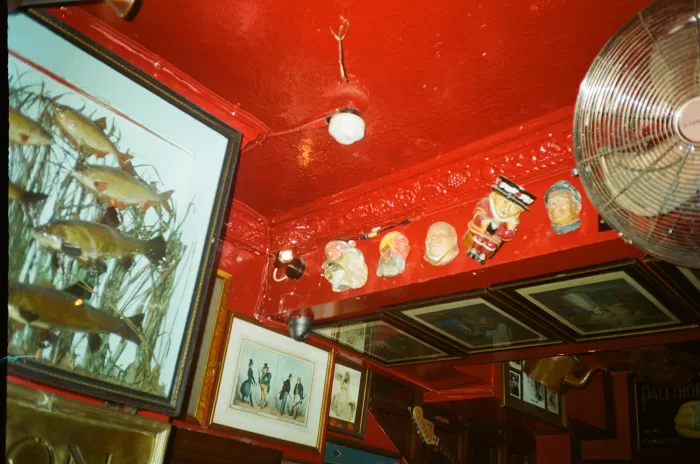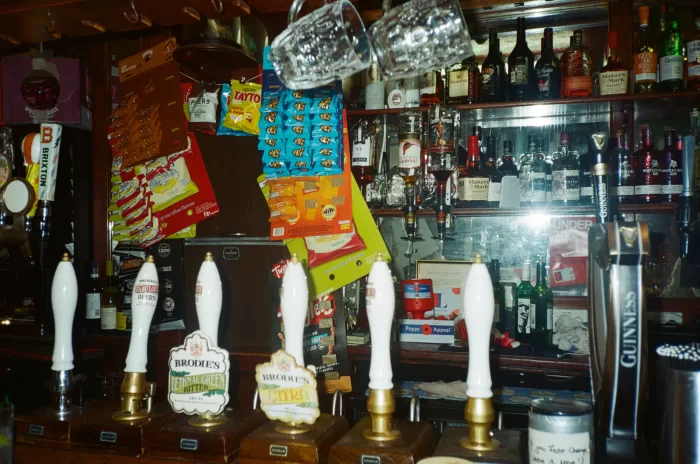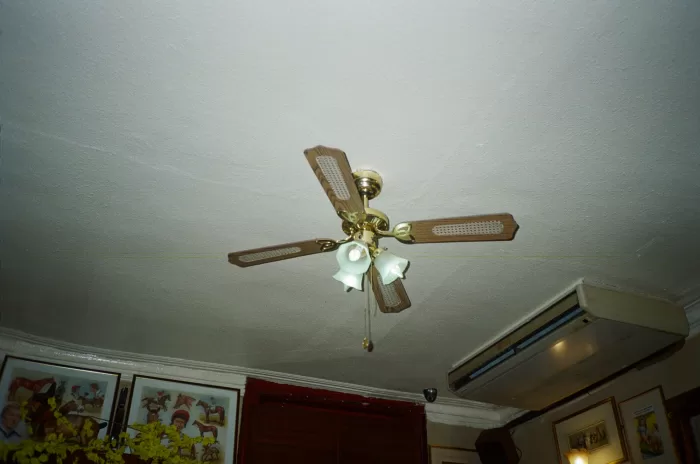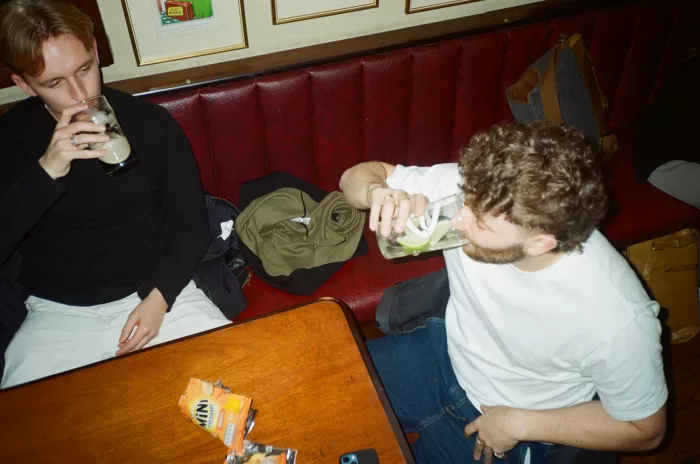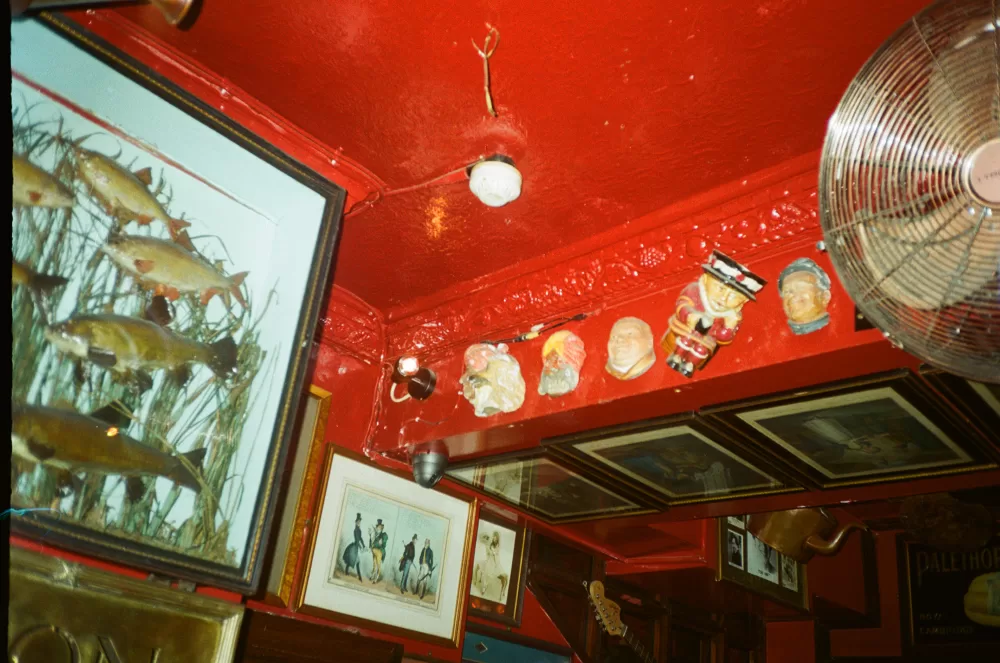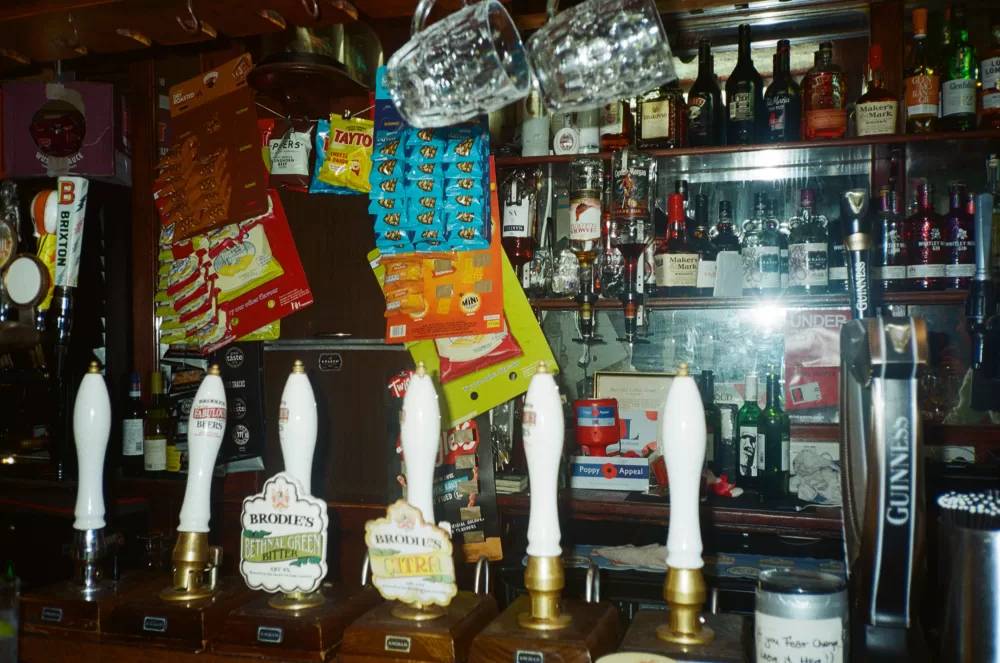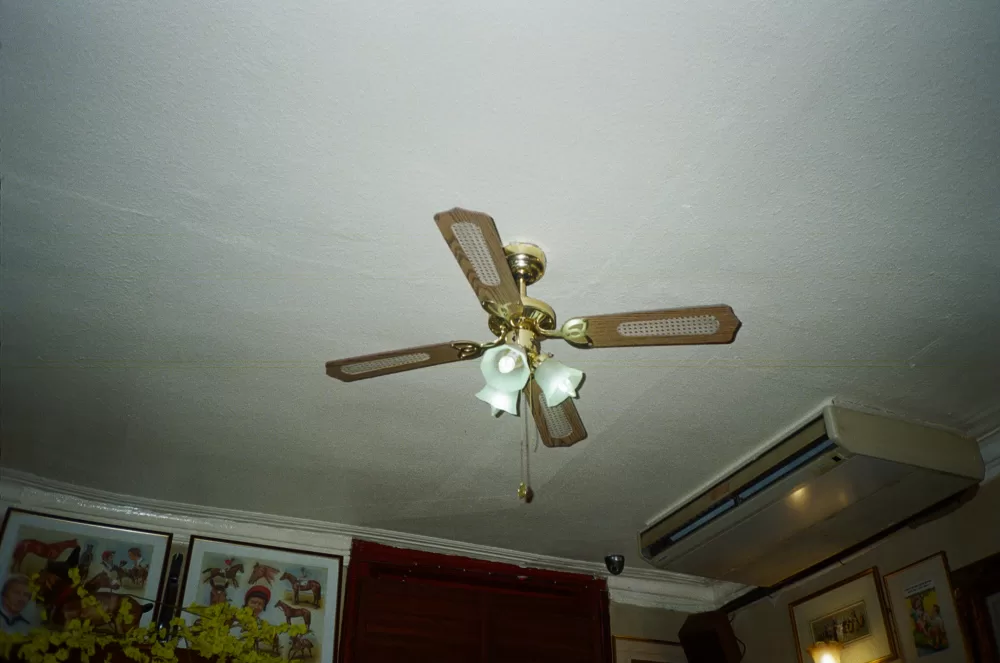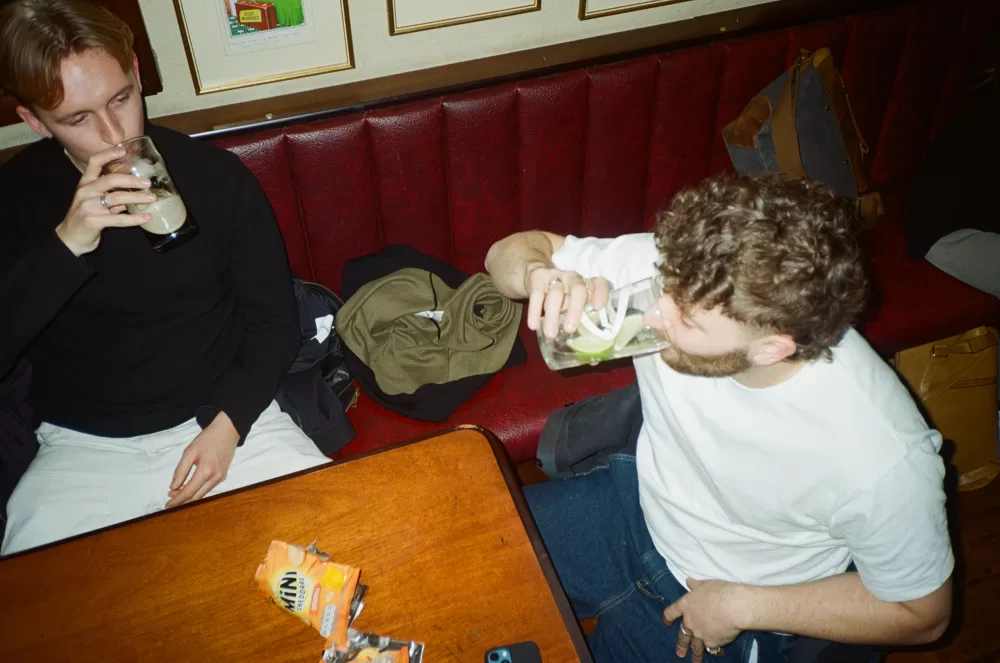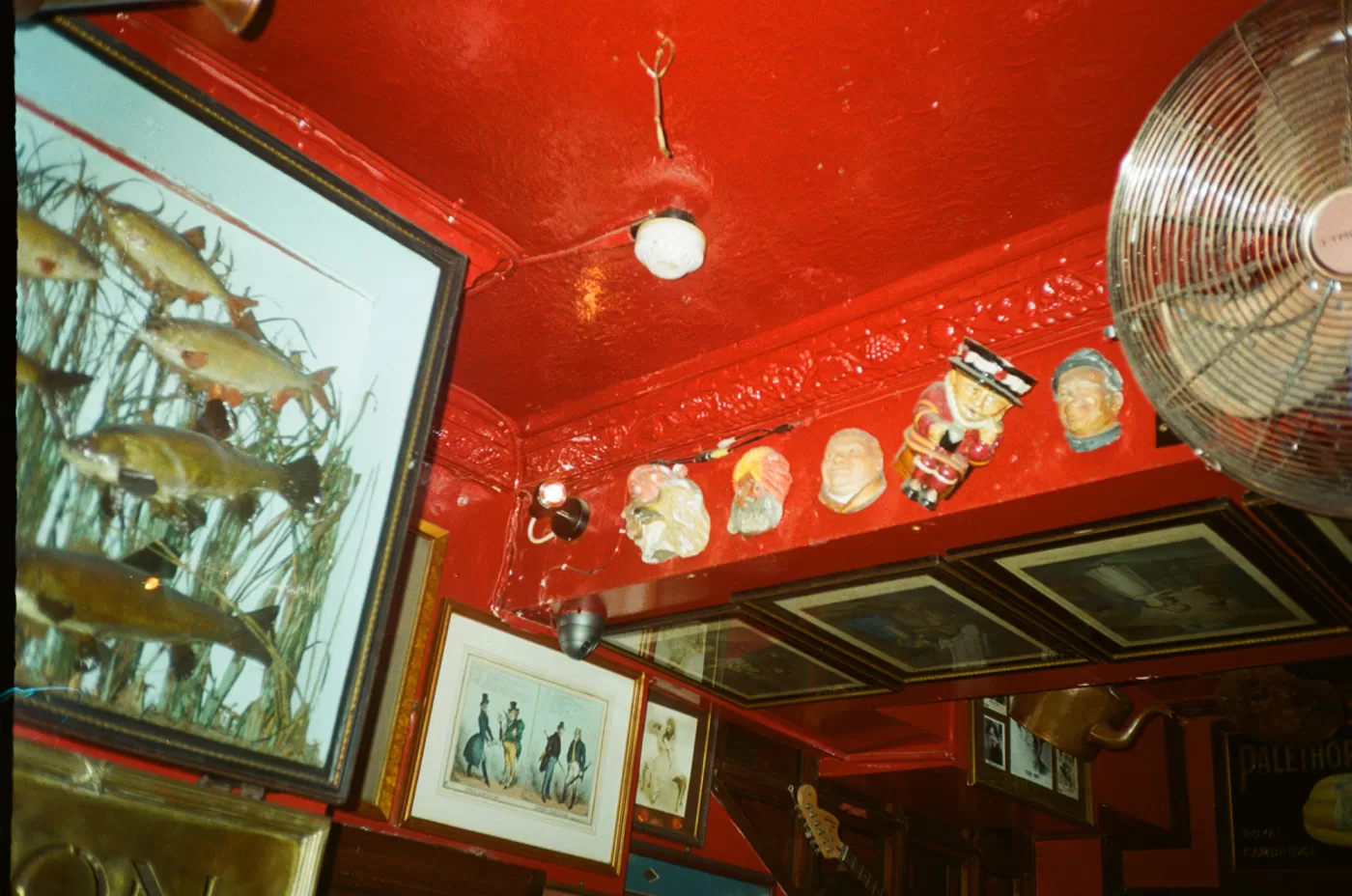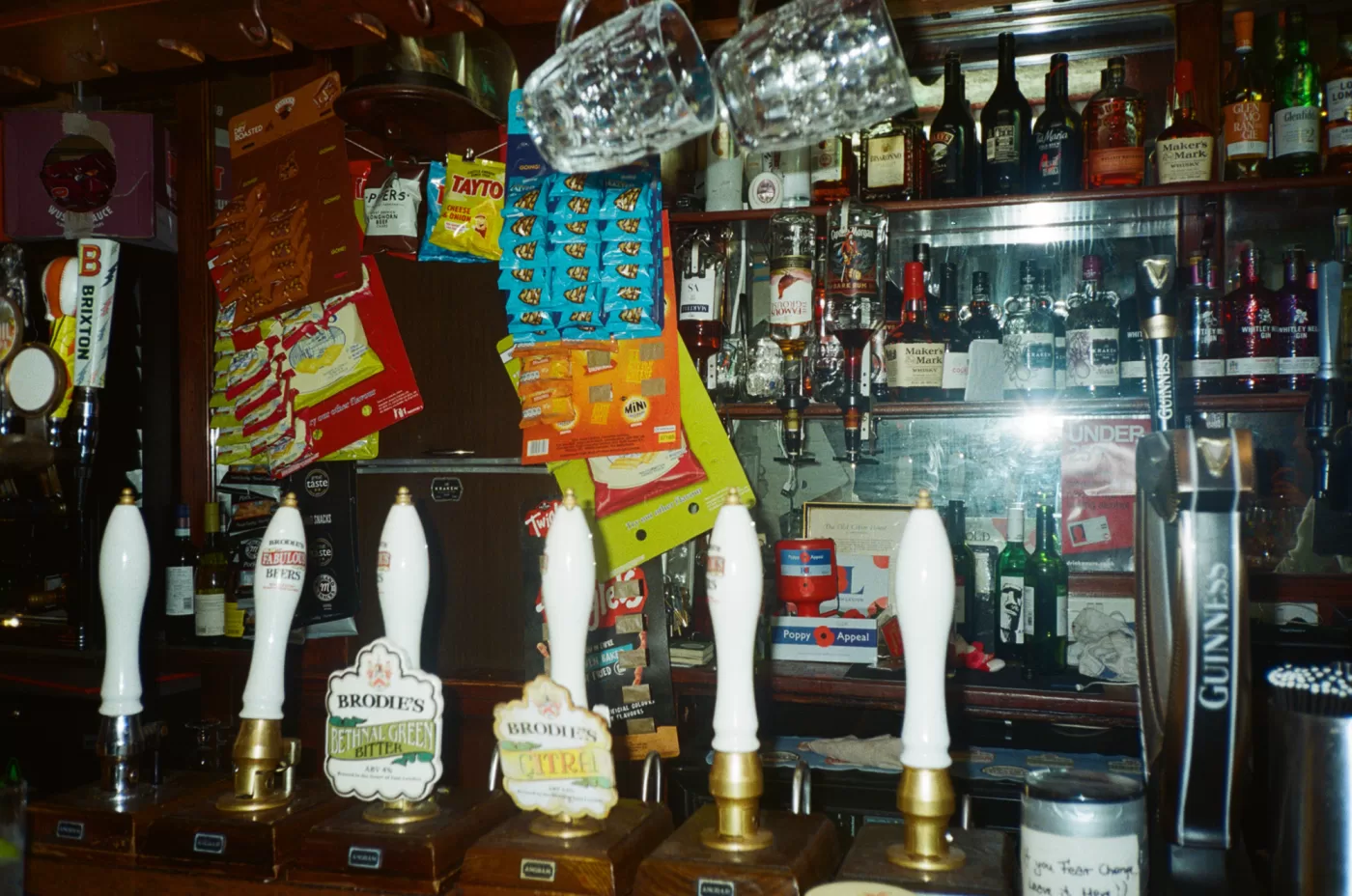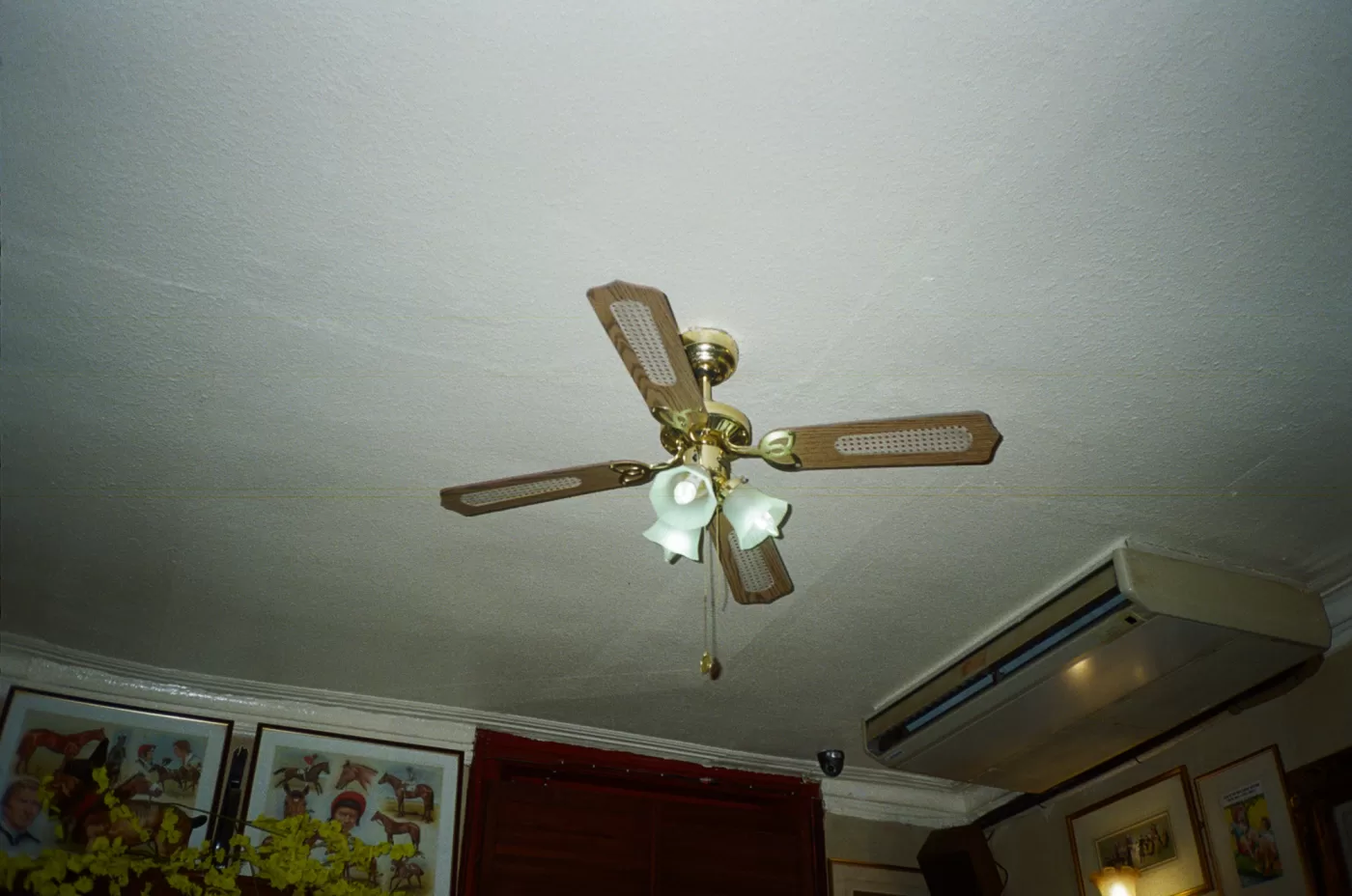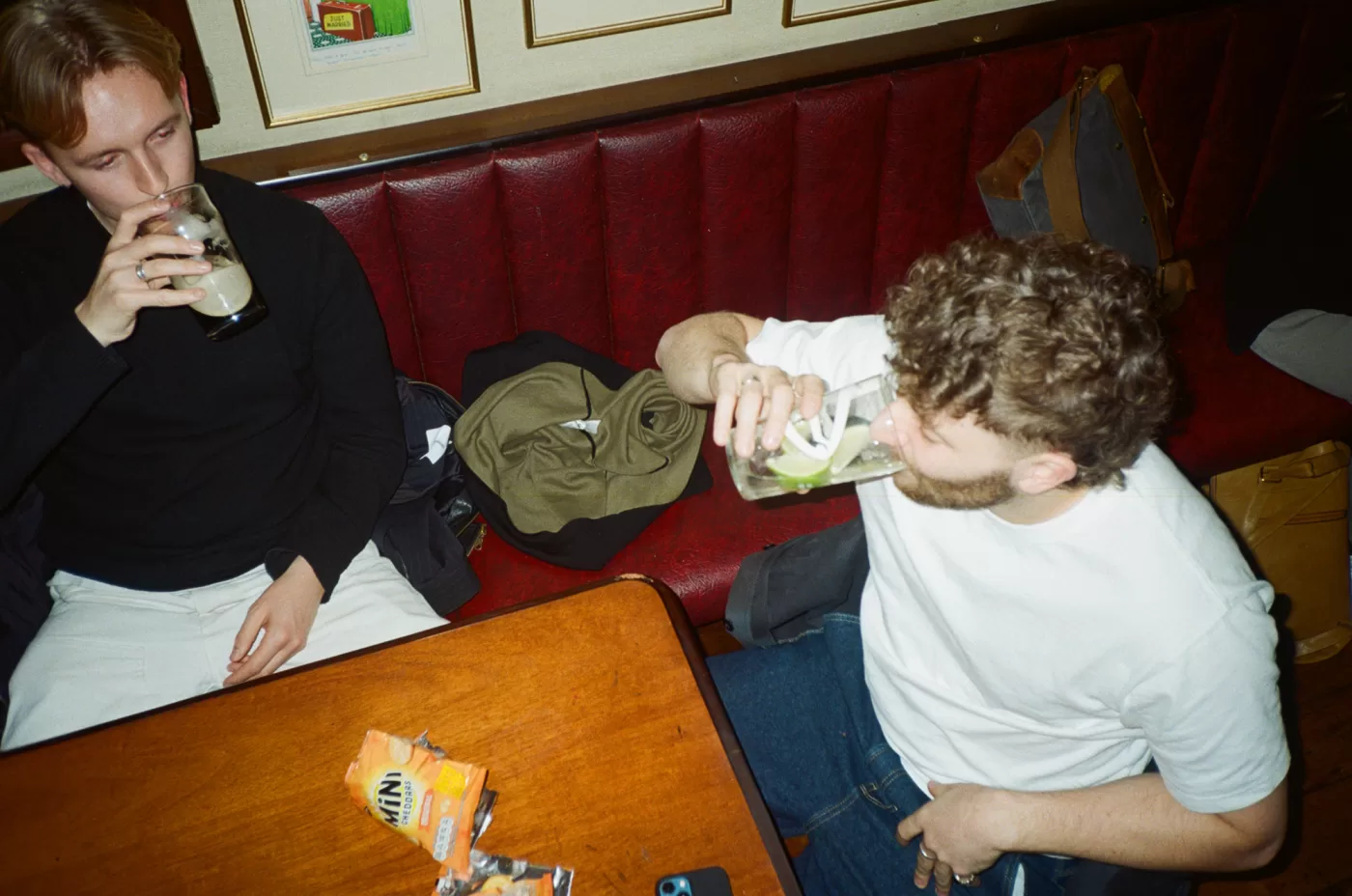George Richardson and Leon Scott-Engel walk into a bar
14 min read
Plaster invited the two artists to a pub crawl of Soho to discuss their work and how it deals with masculinity, authenticity, community and memory
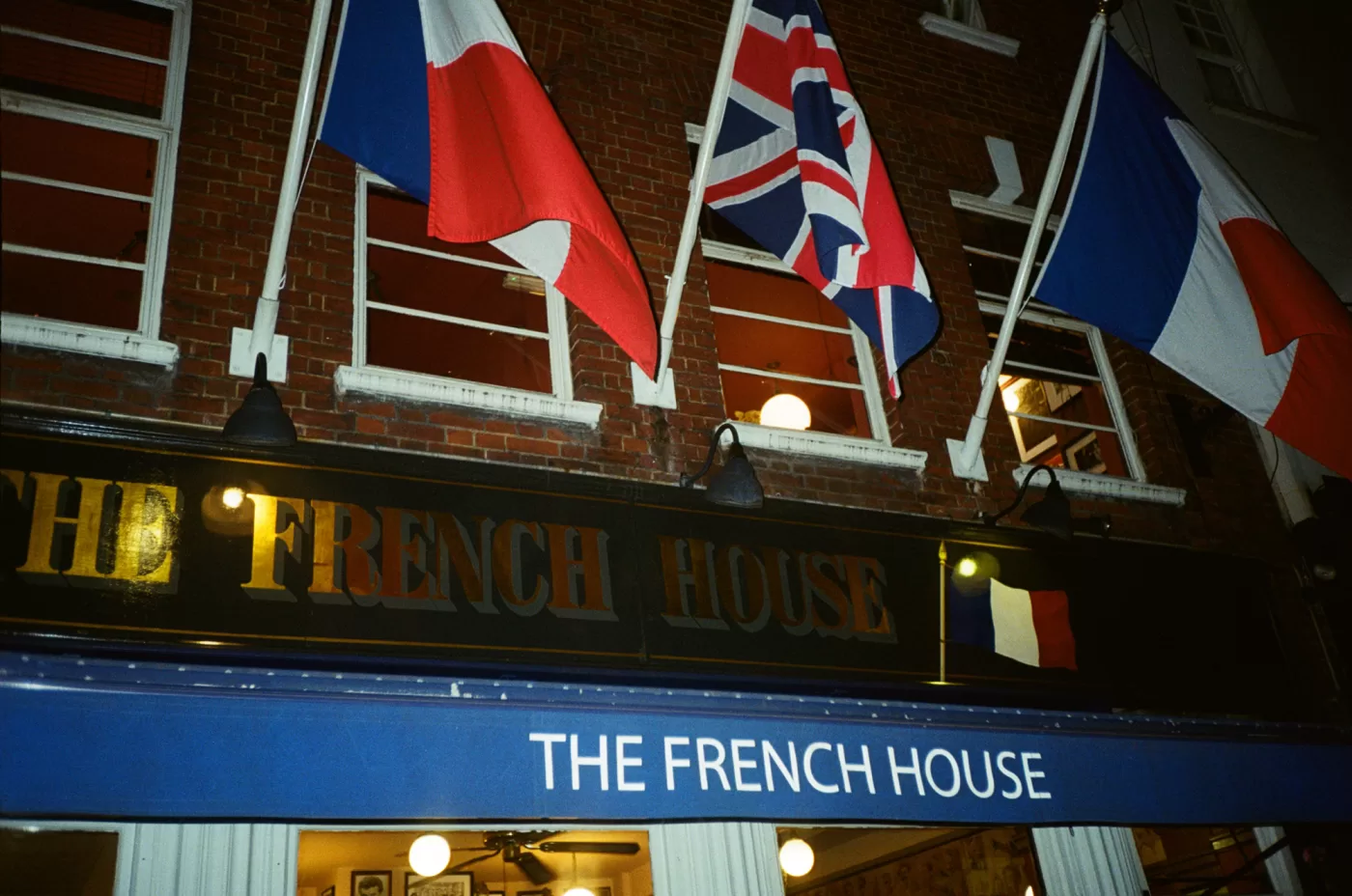
The French House is always busy. It trades on its reputation rather than its beer, which is always served in half pints. This is where artists come to feed their nostalgia and to pretend they’re the next Francis Bacon, Lucien Freud, Brendan Behan or Dylan Thomas.
The French House is busy but we’ve found ourselves a corner and a couple of stools. Leon Scott-Engel is already sat down and as George Richardson grabs a seat he tells us a man has just tried to buy his leather jacket off him. To be fair, it is a great jacket. The bar is sticky and when we clink our little half pints we have to first peel the glasses off the wood. It’s a Thursday evening in late November and we’re a few hours into a pub crawl around Soho, courtesy of the company card.
- I’d invited the two artists out because I’d just seen their joint show ‘Another Round’, co-hosted by Pipeline Gallery and Flexitron Gallery in Islington. Shown side by side, Richardson’s repurposed, steam-bent snooker cues and Scott-Engel’s bruised, handmade, linen punch bags seemed to speak to each other. I was intrigued by their separate yet parallel approaches to the same subjects: masculinity, violence, control, sentimentality, authenticity, English culture and the art world. I wanted to get them out of their studios and into the streets to reflect on their recent work. They were keen, and so, here we are.
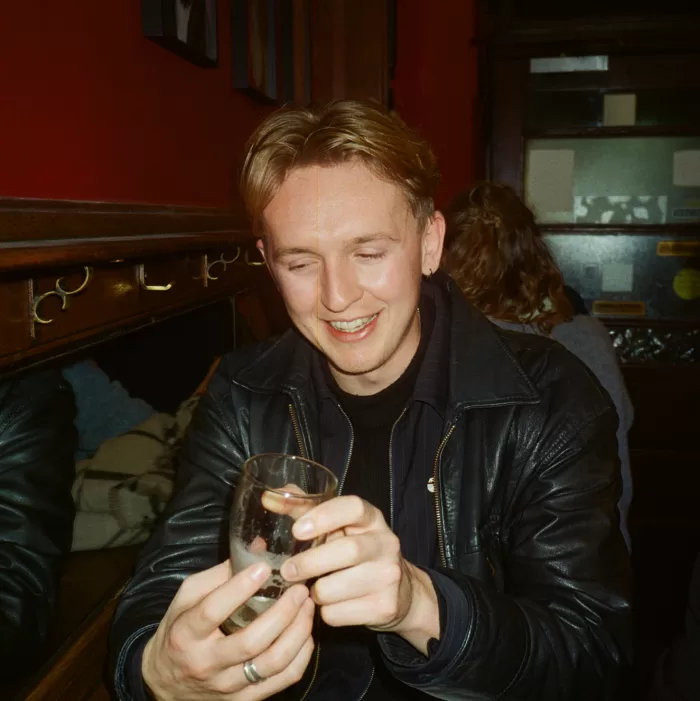
What does George Richardson listen to in the studio? "Fred Neil, Norah Jones, Richard Hawley, Sierra Ferrell and a little bit of Chris Isaac, but not too much.” If he listens to too much jazz gets a little romantic, “I get ahead of myself when I do that. I think my collages are maybe better than they are.”
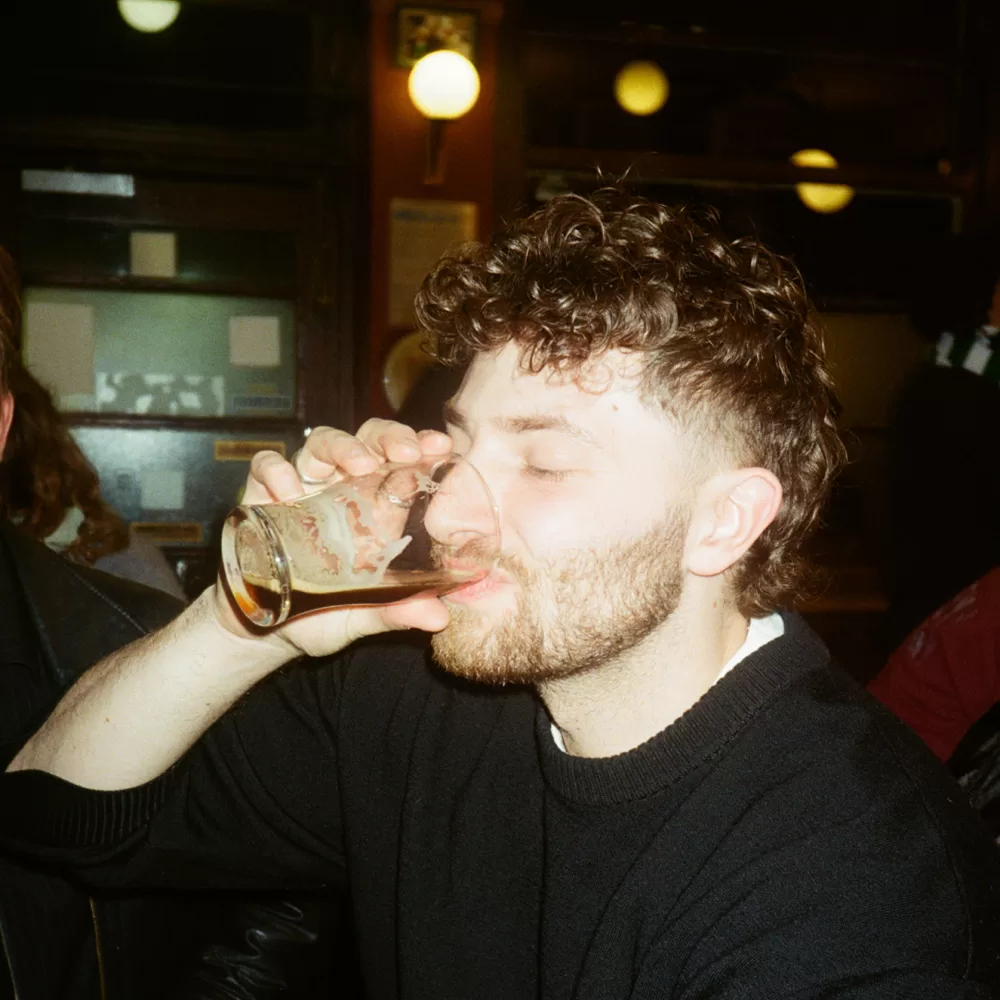
Leon Scott-Engel listens to: “Freddie Hubbard, Cannonball Adderley, Clifford Jordan. But then also, I had a real Britpop phase at one point last spring…" Besides his art, he visits jams sessions at Vortex, Dalston, where he plays piano, jazz clarinet and sings.
They’ve been drinking Guinness for a while now. Richardson says he drinks it for its “forgiving hangover”, for Scott-Engel it’s the closest he can find down here to Tennent’s (which he acquired a taste for when he was at Glasgow School of Art) but he’ll often have a cocktail or aperitivo. When he doesn’t want to drink he’ll have a lime and soda. Richardson goes for Guinness Zero, nobody asks questions when you’re holding a pint, he says, when they see you with a soft drink you always have to justify yourself.
Richardson is from Cheltenham. He moved down to study for a BA at Central Saint Martins, he spent a year in the US at the Pratt Institute, before returning to London to study for an MA at the Slade. Scott-Engel was born in London in 1999 and moved up to Glasgow to study at the city’s art school. He found the small art scene supportive, and enjoyed his time up there, but moved back down after graduating.
The two have such an easy rapport that it’s hard to believe they only met in April, when Scott-Engel was showing his boxing works in a group show at Morgan Wyn’s Split Gallery. Richardson had just produced a series of ugly, half-melted ‘anti-trophies’ that were inspired by his great grandfather, an amateur lightweight boxing champion and a troubled man. When he saw Scott-Engel’s battered punch bags, he thought of his grandma’s bruised skin. “Fucking hell… I had to know where that was coming from and what that meant. If it was just aestheticising violence there’d be an issue, but it wasn’t that, it was far from that.” They chatted, hit it off, and within days decided to do a show together.
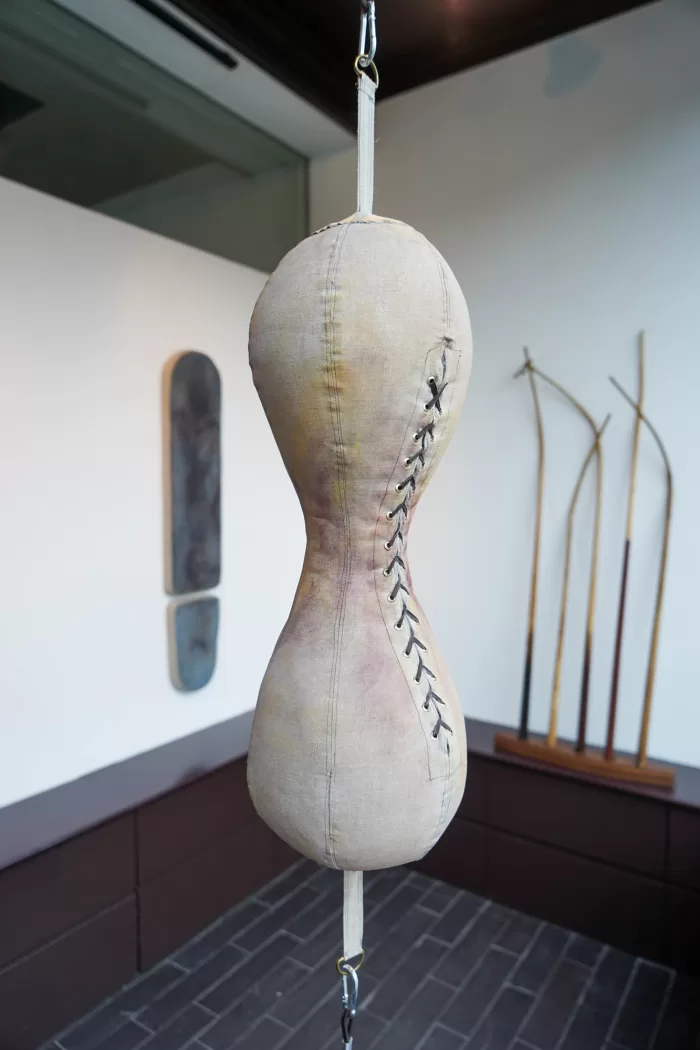
Leon Scott-Engel, Waist Trainer, 2023
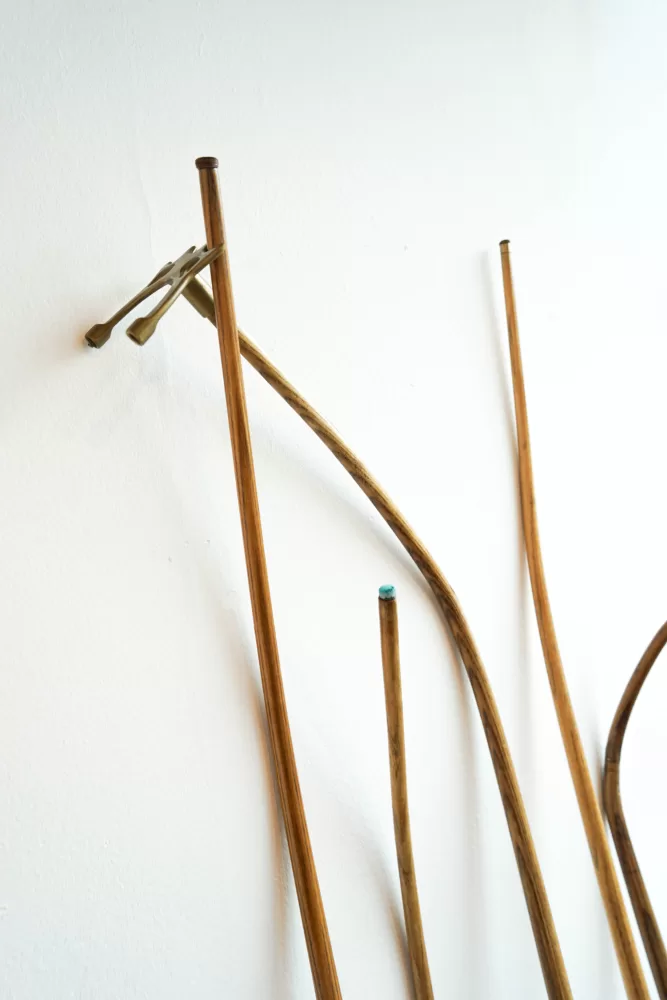
George Richardson, I'll stay for one, 2023
I mention that I first saw Richardson’s work at his Slade degree show. There, he showed installations of furniture and fittings acquired from pubs and clubs, lifesize paintings of green baize snooker tables, his bent snooker cues, and a fountain made from a hand pull pump pouring an infinite pint. He’s pleasantly surprised. Degree shows aren’t always enjoyable, he says, they’re pressure cookers. “It feels like an arrival point, a destination. It’s like ‘this is it, this is the end, this is a mini white cube show, this is me summing up everything I’ve done,’ and I never felt like the Slade was the end. I felt like I was just getting started.”
Richardson says the material for his degree show was scavenged from a skip that his grandad (“the least sentimental man around”) had filled. I ask him, is he sentimental? “I’m still working out what I believe about lots of things.” Scott-Engel, by comparison, is. “I grew up surrounded by art, my parents are creative. They’re very sentimental people … You hold a sentimental place for your art, especially certain works, and then when you let them out into the world you give up control over the idea and you let other people experience it.”
I go to the bar for a Guinness, a Meteor and a Campari soda for Scott-Engel. I leave them with another question: can sentimentality spill over into resentment? When you’re too close to your art, can you come to hate it?
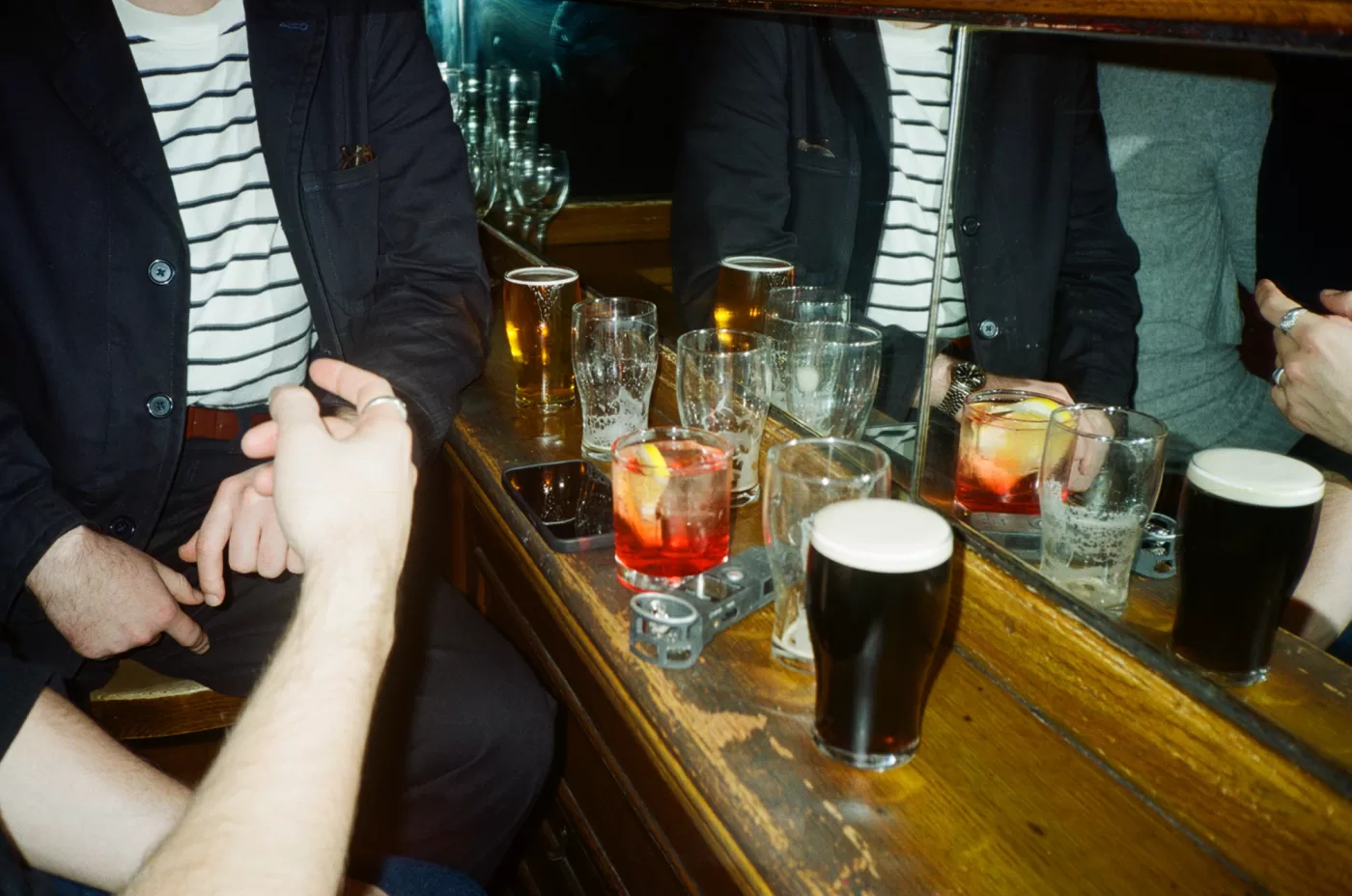
While I’m at the bar they’ve got their phones out. They’re trying to find the painting that all the drinks lined up in front of the mirror reminds them of. It’s Edouard Manet’s A Bar at the Folies-Bergère (1882).
“I think some of my best works I’ve hated at some point.” Scott-Engel says. “I think you spend so much time doing this expansive body of work, exploring one thing in depth… By the end of it, you’re at a point where you’ve seen it so much and you are so close to it that you just despise it, because you’re ready to do the next thing. At the same time, that body of work has unveiled something new for you to move on to, which in itself is an exciting moment.”
Richardson: “I’m very suspicious of anyone that loves their own work. But that doesn’t mean the same as believing in your work.” He says that when he’s alone in the studio there are moments where you can see the good in it, and it feels right, but that it’s dangerous to chase that feeling. “You end up trying to make works that are like that again. And you’re not even chasing the work, you’re chasing the feeling of how it felt when you first made that work.”
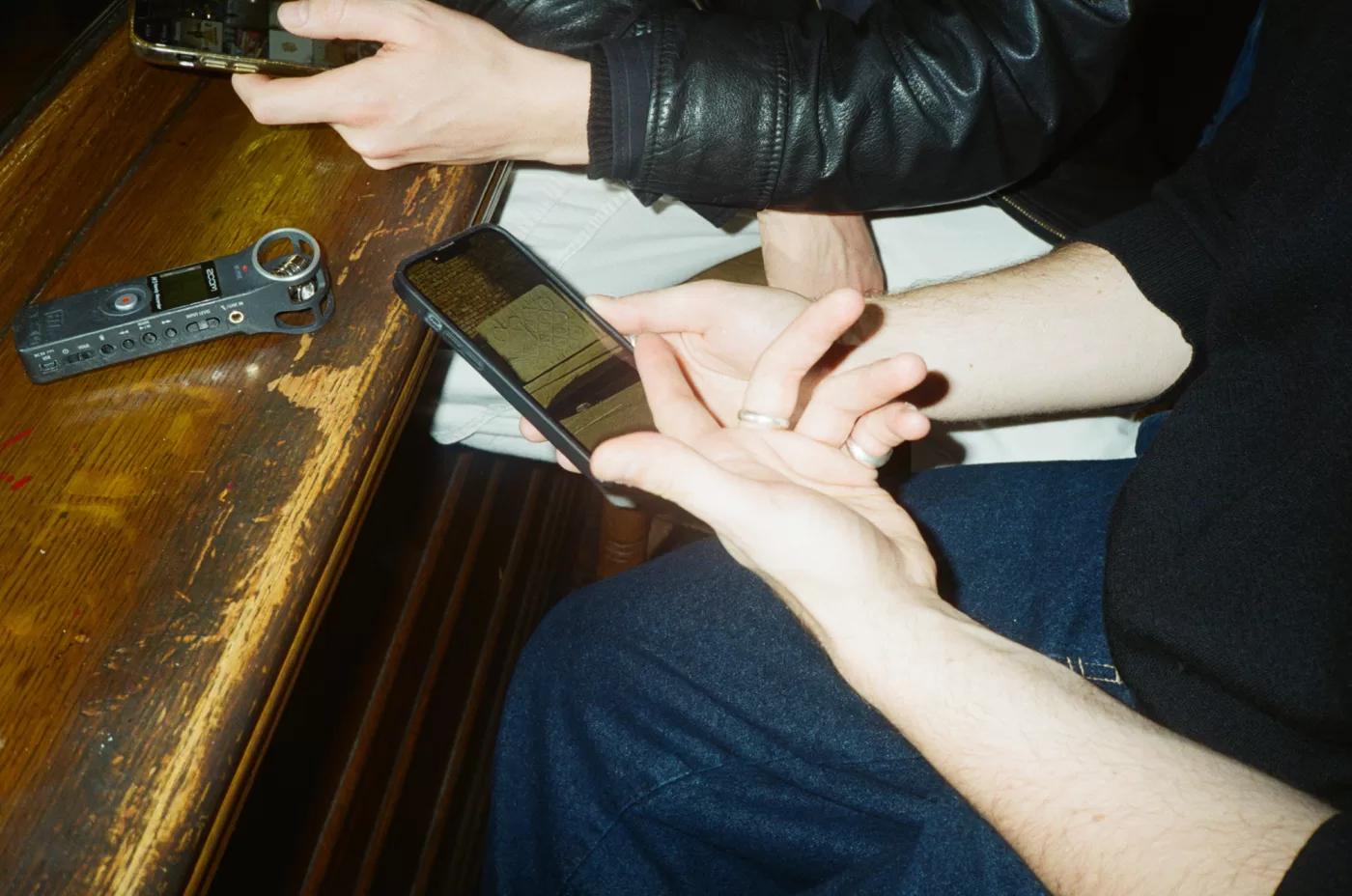
Richardson has 79,000 pictures on his camera roll. Today he’s photographed: A drawing he made in Soho house; a hot chocolate; a picture taken at Sadie Coles; a screenshot of an art review; a screenshot of a message from a man picking up a cabinet; a picture of a friend having a mulled wine. Scott-Engel has barely taken any photos today; one of a mattress slumped in the street and one of a pile of leaves.
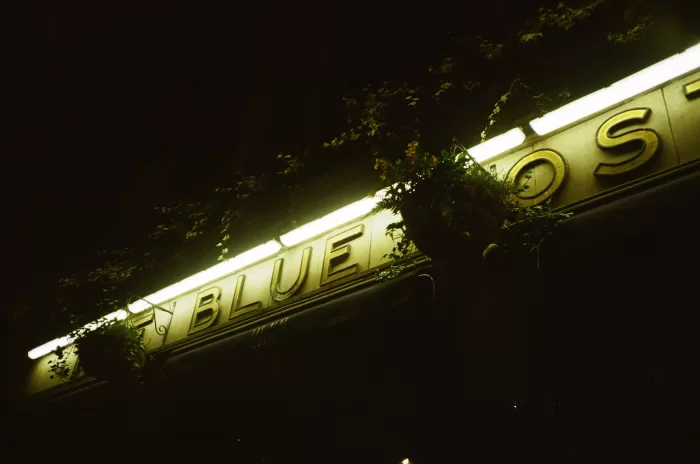
We think about stopping at The Blue Posts, aka 'That London Pub', but it’s rammed and we don’t fancy being cancelled by Tiktok teens

Richardson: “I love mascots. I believe they’re personifications of belief systems.”
Jack Solomon’s
Scott-Engel mentions that there’s an “amazing little speakeasy” down on Great Windmill Street called Jack Soloman’s. What’s now a cocktail bar was once the former boxing gym of the eponymous Jack Solomon, regarded by many as England’s greatest boxing promoter. New plan. We get our coats and head straight there. Outside, a brief check from the bouncer, who reminds us to be nice lads and make his job easy, then downstairs. It’s a wide open room with a high ceiling, dim lights, low music, velvet chairs. Besides us, there are just a few couples on dates. To Richardson’s disappointment there’s no Guinness here, so it’s negronis all round. Soon, the conversation circles back to their recent show, ‘Another Round’.
“It could easily have felt like an extremely macho show,” Richardson says, “with the snooker and the boxing and pubs, but the crucial difference is the intervention that happened there: everything was subverted or changed; the snooker cues were flaccid, the boxing bags are bruised.” Scott Engel adds, “We recognise the boxing kit as objects rather than artworks, which means you look at them in a different way.” He’s choosing his words carefully. “With all of our work, in our show and across our whole body of work, there’s a sensitivity to the subjects and materials being used. And it’s all about handling these objects with care. I mean, that ended up being the title of my solo show [‘Handle With Care’, at Pipeline].” Richardson says that their work questions, rather than tells: “I embrace the ambiguity and the distance between the objects and its reference point.”
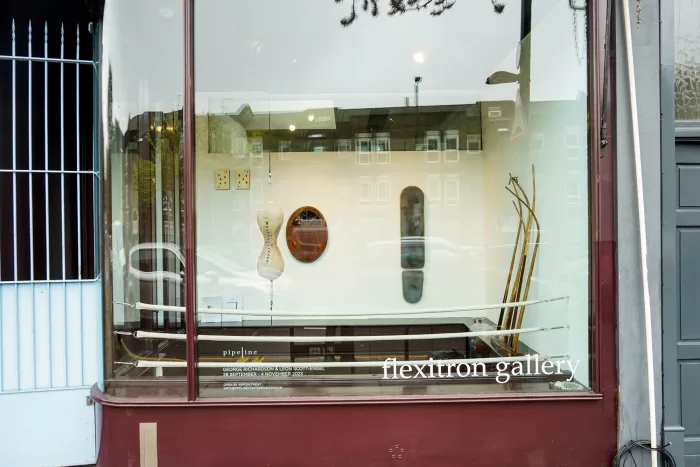
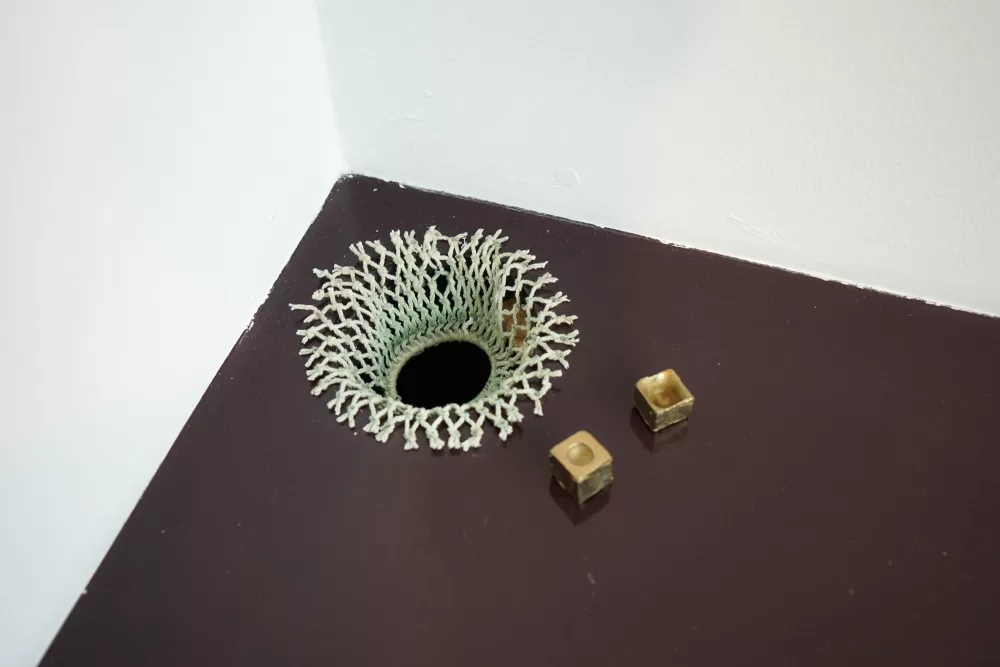
George Richardson, Solid brass snooker chalks, 2023
Scott-Engel describes seeing Richardson’s work the lights are on but nobody’s home (a pub table hung on the gallery wall, lit by an antique light) for the first time: “You see a silhouetted reflection of yourself in that shined surface. You talk about this chord from your throat to your belly, it pained like that, similar to like a Bacon or Guston would. I looked at it and I saw myself and my relationship to booze and pubs and alcohol and my family’s relationship and generational addiction and the pain and the difficult moments, but also the joy of being in a pub with your friends and family and the shared environment. And it was this wave of emotion I didn’t think you could get from a pub table. It was almost like I was looking at a painting.” “It is a painting,” Richardson says, “I mean, the tables are three different shapes, there was a rectangle, a circle, and a square, which are three conventional art history painting shapes, especially in Dutch paintings.”
They both emphasise that they don’t want to be typecast. Their shared interest isn’t in violence and drunkenness, it’s in the softness and touch and the implied presence of others. In Richardson’s work, that takes the form of his communal objects, cues, tables, chairs, glasses. They all bear traces of former users in their marks and scratches and layers of grime. They’ve been taken out of their communal context, isolated and turned into art. With Scott-Engel, besides the sparring pads and ring ropes are his wax casts, metalwork and curved paintings that depict mattresses and mirrors. Everything points to another person.
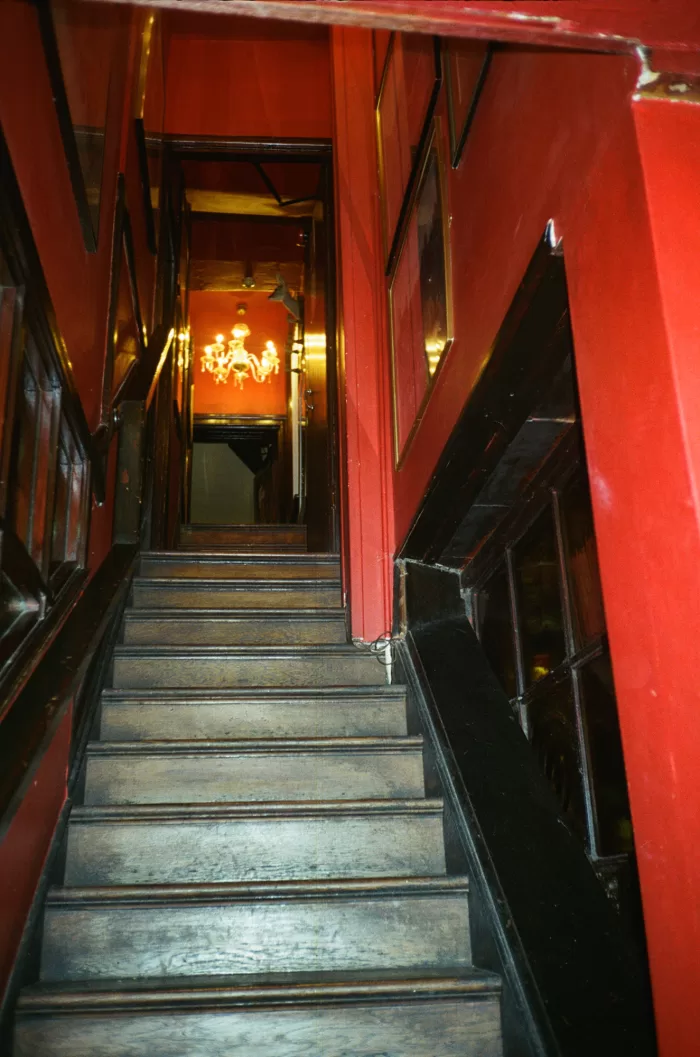
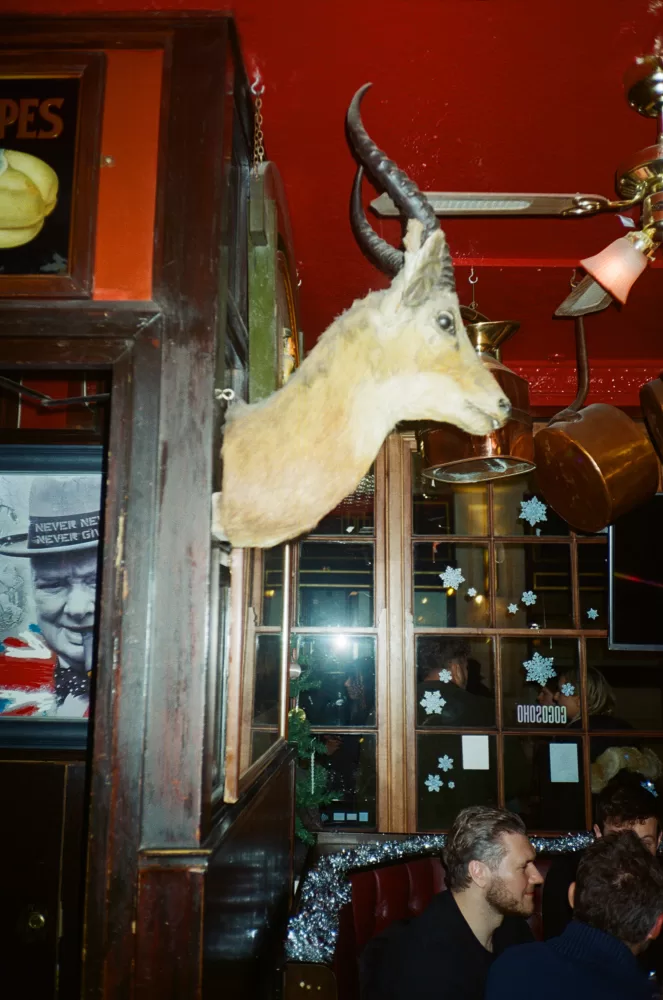
The Old Coffee House
Back up Great Windmill Street, round the corner and across Beak Street to The Old Coffee House. Things are getting hazy now. Time for reflection. Richardson starts us off.
“You know, this is the first year I felt like I’ve got a bit back. I’m being offered shows. I feel like the work is not just for me anymore.” Scott-Engel talks about the importance of valuing your work as a young artist. “I think that can be a really hard thing when you’re starting out, and something that I’ve definitely struggled with for a time is understanding that your work is valuable, regardless of anything commercial.”
He continues. “I think it’s been a real success in terms of taking the vision of our practices together and finding an interesting dialogue. Taking away from it, I feel that there’s room for my work to grow. This conversation that’s emerged around implied physicality, and residues and presence and implied presence is something that I’m really going to take forward.”
What’s next for them? Richardson says their Pipeline show was simply the beginning. “If we had more physical space, we could do more. We spoke about this show being a proposal for future shows because we both have a lot more work. You know, I make a hell of a lot of work, and it’s a real filtering that happens.”
And what’s next for us? We could go for one more, but we’re starving. We call it a night. We finish our drinks off and as I stare into the bottom of my pint glass I think of the receipts in my pocket and my editor’s face on Monday morning. Ah well, you’ve got to roll with the punches, you’ve got to be a man.
